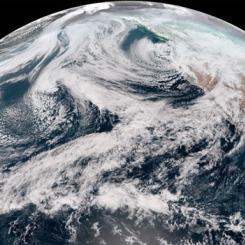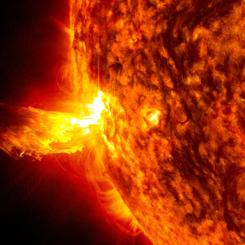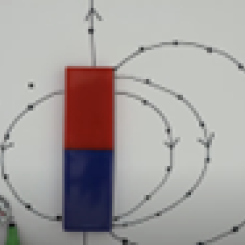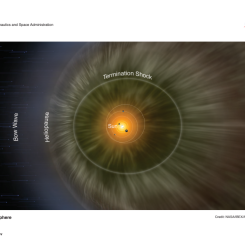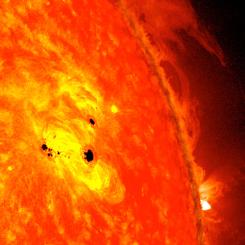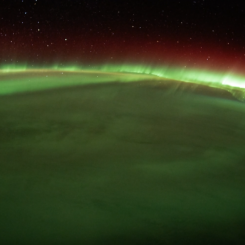Lesson Plans
Magnetospheric Multiscale (MMS) Spacecraft Model
Overview
Learners will build a 2D model of the Magnetospheric Multiscale (MMS) Spacecraft model.
Materials Required
- MMS Bookmark and Scale Model Activity Handout (print one sided)
- (5) Pennies
- (8) pieces of dried spaghetti
- Tape
- Scissors
Procedure
Remember to never look directly at the Sun without proper safety equipment.
Context on Magnetosphere:
The Sun's and Earth's magnetic fields connect and disconnect explosively, transferring energy from one to the other. This energy can create space weather and geomagnetic storms. This process of connecting and disconnecting magnetic fields occurs throughout the universe and is known as magnetic reconnection.
Watch: Video: NASA ScienceCasts: Earth's Magnetosphere.
This video gives an overview of Earth’s magnetosphere and how NASA missions collect data on space weather.
Have learners consider the following questions:
- Why is Mars’ atmosphere so thin?
- What does it mean that Earth’s magnetosphere is permeable?
- How would you describe magnetic reconnection?
Context on MMS:
One of the NASA missions that investigates the effects of space weather on Earth is NASA’s Magnetospheric Multiscale (MMS) mission, which collects data on how the Sun's and Earth's magnetic fields connect and disconnect explosively, transferring energy into Earth’s atmosphere.
Watch: How Will the 4 MMS Spacecraft Launch and Deploy?
This video shows the deployment of the four identical spacecraft that make up NASA’s MMS mission and the instruments on the spacecraft.
Have learners consider:
- Why are there four spacecraft and what shape is their formation in?
The Spin-plane Double Probe (SDP) instrument and the Axel Double Probe (ADP) instrument work together to measure the 3D electric field, and the Magnetometer instruments measure the magnetic field. Magnetic fields and electric fields are perpendicular to one another. The fields affect one another.
Model:
Direct learners to the Handout_MMS Paper Model. Direct learners to cut out the paper model and the accompanying book mark, tape the front to the back, and follow the directions on panel 3.
Have learners complete their models by cutting out and attaching the front and back of the model by taping the four ‘panel’ tabs. Each panel is numbered so you can match the front to the back.
Have learners follow the directions on panel 7 and stack and tape five pennies together to create a base for the model. Learners can also attach eight pieces of dried spaghetti to simulate the booms coming off of the spacecraft.
Find more information about this activity at MMS Bookmark and Scale Model Activity.
Explain:
Earth’s magnetosphere has different parts, as diagrammed on the bookmark that accompanies the model. The different parts are determined by how the solar wind interacts with the magnetosphere.
- Dayside Magnetopause: The location in space where Earth's magnetic field balances the pressure of the solar wind. It is located at the edge of the magnetosphere.
- Solar Wind: The plasma of charged particles coming out of the Sun in all directions at supersonic speeds.
- Plasma Sheet: A sheet of plasma that extends down the magnetotail dividing the two lobes of the Earth's magnetic field.
- Magnetotail: The extreme extension of a magnetosphere, on the side of a planet opposite the Sun, caused by the solar wind.
- Interplanetary Magnetic Field (IMF): The solar magnetic field carried by the solar wind among the planets of the solar system.
Teachers who are interested in receiving the answer key, please complete the Teacher Key Request and Verification Form. We verify that requestors are teachers prior to sending access to the answer keys as we’ve had many students try to pass as teachers to gain access.
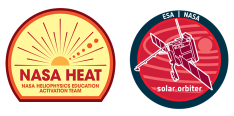
Disciplinary Core Ideas:
- PS2B: Types of Interactions
- ESS1A: The Universe and its Stars
Crosscutting Concepts:
- Patterns
- Cause and Effect
Science and Engineering Practices:
- Developing and Using Models
- Students will be able to describe the advantages of a planet having a magnetosphere.
- Students will be able to identify why NASA studies Earth’s magnetic field.
- What is a magnetosphere?
- How does the magnetosphere protect Earth from space weather?
- The process of connecting and disconnecting magnetic fields occurs throughout the universe and is known as magnetic reconnection. The Sun's and Earth's magnetic fields connect and disconnect explosively, transferring energy from one to the other. This energy can create space weather and geomagnetic storms.
- The MMS mission has four identical spacecraft, flying in a tetrahedron formation, to capture three-dimensional data of Earth’s magnetic field.
- Earth’s magnetic field has different parts, which is determined by how the solar wind interacts with the magnetosphere.
- The dayside magnetopause is the location in space where Earth's magnetic field balances the pressure of the solar wind. It is located at the edge of the magnetosphere.
- The magnetotail is the extreme extension of a magnetosphere, on the side of a planet opposite the Sun, shaped by the solar wind.
NASA studies magnetic reconnection because it is a key process in how energy and particles move through space. It happens when magnetic field lines break and reconnect, releasing bursts of energy that can cause space weather events like solar flares and geomagnetic storms. These events can affect satellites, GPS, power grids, and astronaut safety. Magnetic reconnection also occurs throughout the universe, so studying it near Earth with missions like the Magnetospheric Multiscale (MMS) mission helps scientists better understand the behavior of magnetic fields and energy transfer across space.
NASA also studies space weather to protect the technology and systems we rely on every day. Space weather caused by the Sun can interfere with communications, satellite operations, and power systems on Earth. It can also be dangerous for astronauts and future space missions. By monitoring the Sun and its interactions with Earth’s magnetosphere, NASA helps us prepare for and respond to these events, making both Earth-based and space-based technologies more reliable and safer.
Find more information about this activity at MMS Bookmark and Scale Model Activity.
- Internet Required
- Color Printer

